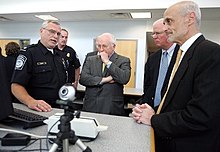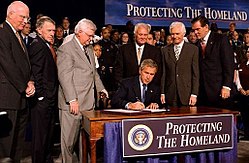In an August 5, 2002 speech, President Bush said: "We're fighting ... to secure freedom in the homeland."
Prior to the creation of DHS, American presidents had referred to the
U.S. as "the nation" or "the republic", and to its internal policies as
"domestic". Also unprecedented was the use, from 2002, of the phrase "the homeland" by White House spokespeople. The choice of this phrase raised questions regarding the self-image of the USA.
The Department of Homeland Security was established on November 25, 2002, by the Homeland Security Act of 2002. It was intended to consolidate U.S. executive branch organizations related to "homeland security" into a single Cabinet agency. The following 22 agencies were incorporated into the new department:
 Prior to the signing of the bill, controversy about its adoption centered on whether the Federal Bureau of Investigation and the Central Intelligence Agency
should be incorporated in part or in whole (neither were included). The
bill itself was also controversial for the presence of unrelated "riders",
as well as for eliminating certain union-friendly civil service and
labor protections for department employees. Without these protections,
employees could be expeditiously reassigned or dismissed on grounds of
security, incompetence or insubordination, and DHS would not be required
to notify their union representatives.
Prior to the signing of the bill, controversy about its adoption centered on whether the Federal Bureau of Investigation and the Central Intelligence Agency
should be incorporated in part or in whole (neither were included). The
bill itself was also controversial for the presence of unrelated "riders",
as well as for eliminating certain union-friendly civil service and
labor protections for department employees. Without these protections,
employees could be expeditiously reassigned or dismissed on grounds of
security, incompetence or insubordination, and DHS would not be required
to notify their union representatives.
The plan stripped 180,000 government employees of their union rights. In 2002, Bush officials argued that the September 11 attacks made the proposed elimination of employee protections imperative.
Congress ultimately passed the Homeland Security Act of 2002 without the union-friendly measures, and President Bush signed the bill into law on November 25, 2002. It was the largest U.S. government reorganization in the 50 years since the United States Department of Defense was created.
Tom Ridge was named secretary on January 24, 2003 and began naming his chief deputies. DHS officially began operations on January 24, 2003, but most of the department's component agencies were not transferred into the new Department until March 1.
 After establishing the basic structure of DHS and working to
integrate its components and get the department functioning, Ridge
announced his resignation on November 30, 2004, following the
re-election of President Bush. Bush initially nominated former New York City Police Department commissioner Bernard Kerik
as his successor, but on December 10, Kerik withdrew his nomination,
citing personal reasons and saying it "would not be in the best
interests" of the country for him to pursue the post.[citation needed] On January 11, 2005, President Bush nominated federal judge Michael Chertoff to succeed Ridge. Chertoff was confirmed on February 15, 2005, by a vote of 98–0 in the U.S. Senate. He was sworn in the same day.
After establishing the basic structure of DHS and working to
integrate its components and get the department functioning, Ridge
announced his resignation on November 30, 2004, following the
re-election of President Bush. Bush initially nominated former New York City Police Department commissioner Bernard Kerik
as his successor, but on December 10, Kerik withdrew his nomination,
citing personal reasons and saying it "would not be in the best
interests" of the country for him to pursue the post.[citation needed] On January 11, 2005, President Bush nominated federal judge Michael Chertoff to succeed Ridge. Chertoff was confirmed on February 15, 2005, by a vote of 98–0 in the U.S. Senate. He was sworn in the same day.
In February 2005, DHS and the Office of Personnel Management issued rules relating to employee pay and discipline for a new personnel system named MaxHR. The Washington Post said that the rules would allow DHS "to override any provision in a union contract by issuing a department-wide directive" and would make it "difficult, if not impossible, for unions to negotiate over arrangements for staffing, deployments, technology and other workplace matters.
In August 2005, U.S. District Judge Rosemary M. Collyer blocked the plan on the grounds that it did not ensure collective-bargaining rights for DHS employees.
A federal appeals court ruled against DHS in 2006; pending a final resolution to the litigation, Congress's fiscal year 2008 appropriations bill for DHS provided no funding for the proposed new personnel system. DHS announced in early 2007 that it was retooling its pay and performance system and retiring the name "MaxHR".
In a February 2008 court filing, DHS said that it would no longer pursue the new rules, and that it would abide by the existing civil service labor-management procedures. A federal court issued an order closing the case
Creation
In response to the September 11 attacks, President George W. Bush announced the establishment of the Office of Homeland Security (OHS) to coordinate "homeland security" efforts. The office was headed by former Pennsylvania Governor Tom Ridge, who assumed the title of Assistant to the President for Homeland Security. The official announcement stated:The Department of Homeland Security was established on November 25, 2002, by the Homeland Security Act of 2002. It was intended to consolidate U.S. executive branch organizations related to "homeland security" into a single Cabinet agency. The following 22 agencies were incorporated into the new department:

A U.S. Customs and Border Protection Officer addresses Dick Cheney (center), then Vice President of the United States, Saxby Chambliss (center right), a U.S. senator from Georgia and Michael Chertoff (far right), then United States Secretary of Homeland Security in 2005
The plan stripped 180,000 government employees of their union rights. In 2002, Bush officials argued that the September 11 attacks made the proposed elimination of employee protections imperative.
Congress ultimately passed the Homeland Security Act of 2002 without the union-friendly measures, and President Bush signed the bill into law on November 25, 2002. It was the largest U.S. government reorganization in the 50 years since the United States Department of Defense was created.
Tom Ridge was named secretary on January 24, 2003 and began naming his chief deputies. DHS officially began operations on January 24, 2003, but most of the department's component agencies were not transferred into the new Department until March 1.

President George W. Bush signs the Homeland Security Appropriations Act of 2004 on October 1, 2003.
In February 2005, DHS and the Office of Personnel Management issued rules relating to employee pay and discipline for a new personnel system named MaxHR. The Washington Post said that the rules would allow DHS "to override any provision in a union contract by issuing a department-wide directive" and would make it "difficult, if not impossible, for unions to negotiate over arrangements for staffing, deployments, technology and other workplace matters.
In August 2005, U.S. District Judge Rosemary M. Collyer blocked the plan on the grounds that it did not ensure collective-bargaining rights for DHS employees.
A federal appeals court ruled against DHS in 2006; pending a final resolution to the litigation, Congress's fiscal year 2008 appropriations bill for DHS provided no funding for the proposed new personnel system. DHS announced in early 2007 that it was retooling its pay and performance system and retiring the name "MaxHR".
In a February 2008 court filing, DHS said that it would no longer pursue the new rules, and that it would abide by the existing civil service labor-management procedures. A federal court issued an order closing the case

No comments:
Post a Comment